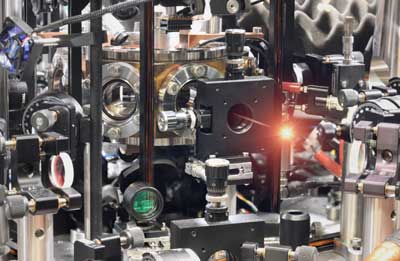| Apr 24, 2019 | |
Quantum distillery for light(Nanowerk News) The distillation of spirits increases the content of alcohol relative to the water content. A similar method developed by a team from the Max Planck Institute of Quantum Optics in Garching works on light quanta – photons. It extracts individual photons from a light source, reduces the unwanted vacuum component, and heralds this event. Such single photons are important quantum bits for the currently emerging quantum information technology. This “photon distillation” can even be concatenated to increase the purity of single-photon light. |
|
| The work recently appeared in Physical Review Letters ("Single-Photon Distillation via a Photonic Parity Measurement Using Cavity QED"). | |
| It is indeed reminiscent of the principle behind the distillation of alcohol – even though the device housed in a laboratory at the Max Planck Institute of Quantum Optics looks completely different from something used for distilling schnapps (figure). Just as distillation increases the alcohol content of a beverage relative to the water content, the Garching experiment increases the proportion of individual photons in relation to the vacuum. | |
| While this motivation may sound strange to the general public, it leads directly to the weird world of quantum physics. Ultimately weak light sources that can deliver exactly one photon play a central role in quantum information technology. | |
| As a quantum bit, a photon can transport the elementary quantum information required for quantum networks, quantum encryption, and quantum computers – just as current digital technology processes individual bits as information carriers. | |
 |
|
| Not quite like distilling schnapps: the Garching 'photon still'. (Image: Max Planck Institute of Quantum Optics) | |
| The construction of single photon sources is a challenge that has been researched worldwide for many years. This sounds astonishing because it takes only a single touch of a light switch to illuminate a room. However, the light from a lamp corresponds to a current of enormous numbers of photons. If a light source is dimmed to such an extent that only individual photons can escape from it, we are confronted with the roll-of-the-dice nature of the quantum world: sometimes there is no photon and then there are two or three photons and so on. It’s a bit like the drops from a still – you can’t predict when the drops will come or how big they will be. | |
| Instead of developing another single-photon light source, the physicists from Gerhard Rempes’ division at the Max Planck Institute of Quantum Optics had a different idea: Their experiment can extract individual photons from the light of any very weak light source – like a still – and reliably report this event. Strictly speaking, it reduces the fraction of pure vacuum compared to the event of obtaining a photon. This is what you learn from Severin Daiß, doctoral student at the institute and lead author of the publication. One of the peculiarities of the quantum world is that the vacuum itself represents a quantum state. If you want to cleanly prepare a photon, no vacuum must be admixed. | |
| Two challenges come together in the new research work of Rempes’ team. The first challenge is to obtain exactly one photon; the second is to reliably detect it. A single rubidium atom solves both tasks in one step. This atom is trapped between two almost perfect mirrors facing each other, in a kind of mirror cabinet. The distance of the mirrors in this “resonator” corresponds precisely to a multiple of half a wavelength of light in which the atom could radiate or absorb its own photon. In this system, the atom can flip between two states like a pointer; this plays an important role here. | |
| “We can use this system of the atom in the resonator as a still for the photon”, says Daiß. The Garching group directs extremely weak laser light – from which they want to obtain a single photon – onto the cavity. There it does something that only works in the quantum world: It “entangles” with the atom-resonator arrangement, thereby forming a combined quantum state. This entangled state makes the system a still: With a measurement on the atom, physicists can extract an even or an odd number of photons from the incident light. | |
| However, this does not work like a switch; the roll-of-the-dice nature of the quantum world prevents a photon from coming through at the push of a button. “What is decisive here is that we can now use the atom as a pointer to report a successful single-photon distillation”, explains Daiß. The physicists let the arrangement “roll” photons but get the dice count reliably displayed. | |
| In conjunction with ultra-weak light, the “odd photon number” mode can now produce events with one photon because more photons are rarely available. The distillation succeeded with a “purity” of 66%, which means that the vacuum content was reduced to one third. | |
| Compared with single photon light sources, this is a good result for a first attempt. This purity can be considerably increased with better optical cavities. The photon distilling elements can be connected in series in order to further increase the purity of the photon that passes through. The quality of the light from other single photon sources can also be improved. It's like making 60% (or higher) vodka from 40% percent vodka. |
| Source: Max Planck Institute of Quantum Optics | |
|
Subscribe to a free copy of one of our daily Nanowerk Newsletter Email Digests with a compilation of all of the day's news. |
